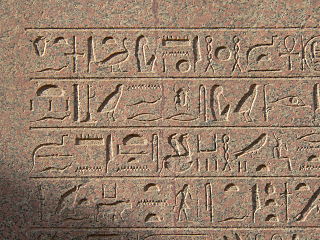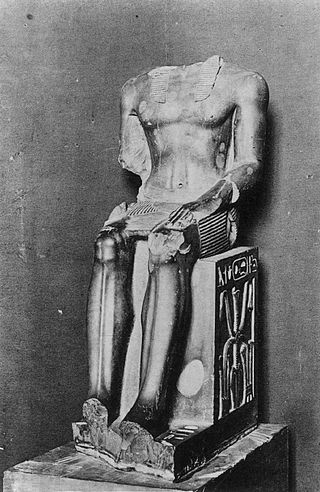Gardiner's Sign List is a list of common Egyptian hieroglyphs compiled by Sir Alan Gardiner. It is considered a standard reference in the study of ancient Egyptian hieroglyphs.
The ancient Egyptian Game piece (hieroglyph), also a Token, or the general term for any gaming-gambling piece, Draughtsman is an ancient hieroglyph. Gaming pieces were certainly required in predynastic times, as the cultural creation of games and entertainment has a long history in most cultures. An ivory-piece lion is known from the Old Kingdom of ancient Egypt; the set contains three lions, and three dog tokens of ivory.

The ancient Egyptian Hill-country or "Foreign land" hieroglyph (𓈉) is a member of the sky, earth, and water hieroglyphs. A form of the hieroglyph in color, has a green line-(banding) at the base of the hieroglyph. The hieroglyph refers to the hills, and mountains, on both sides of the Nile River, and thus the green references the verdant black farming land adjacent to the river proper. It is coded N25 in Gardiner's sign list, and U+13209 in Unicode. It is determinative hieroglyph, simply conveying a meaning, and has no phonetic value.
The pectorals of ancient Egypt were a form of jewelry, often represented as a brooch. These were mostly worn by richer people and the pharaoh.

The Egyptian hieroglyph representing gold, phonetic value nb, is important due to its use in the Horus-of-Gold name, one of the Fivefold Titulary names of the Egyptian pharaoh.
The ancient Egyptian child hieroglyph is part of the Egyptian Gardiner's Sign List hieroglyphs for the beginning core subgroup of Man and his Occupations. It relates to the child, and childhood, and has a version for the Pharaoh, as a child.

The ancient Egyptian Adze on a Wood Block, or Axe in a Block of Wood hieroglyph, Gardiner sign listed no. U20, is a portrayal of the adze. It is used mostly in the cartouches of pharaonic names especially, or other important names.

The ancient Egyptian Sky hieroglyph,, is Gardiner sign listed no. N1, within the Gardiner signs for sky, earth, and water.

The Egyptian hieroglyph Townsite-city-region is Gardiner sign listed no. O49 for the intersection of a town's streets. In some Egyptian hieroglyph books it is called a city plan.

The use of the Spine with fluid hieroglyph is for words showing "length", as opposed to 'breadth',. Some example words for 'length' are: to be long, length, to extend, extended; and for to expand, to dilate, words like: joy, gladness, pleasure, delight.

The ancient Egyptian Two Whips with Shen ring hieroglyph, Gardiner sign listed no. S23 is a portrayal of the Shen ring with two Egyptian flails-(Crook and flail); it is a member of the Gardiner subset for "crowns, dress, staves, etc".

In the Egyptian language, the single stair hieroglyph is used as a determinative.

The ancient Egyptian Scribe equipment hieroglyph 𓏞, or its reversed form 𓏟, portrays the equipment of the scribe. Numerous scribes used the hieroglyph in stating their name, either on papyrus documents, but especially on statuary or tomb reliefs.

The Three-Fox-Skins (hieroglyph) is Gardiner's sign listed no. F31, in the series of parts of animals. It consists of 3-fox skins tied at one end, and hanging, creating flowing skins.

The Land, irrigated hieroglyph represents "district, nome". It is a determinative in the name of provinces and regions in the noun ḥsp, for "garden", "vegetable garden", and "orchard".

In Egyptian hieroglyphs, the hieroglyph is used for the phonetic value of sma, with meanings of to join together, to unite with.

The Hippopotamus (hieroglyph) is Gardiner sign listed no. E25, in the category of mammals. It is used in Egyptian hieroglyphs as a determinative in words designating the animal, in Egyptian as db, and kh3b.

The Pharaoh-seated, with flail & red crown hieroglyph is Gardiner sign listed no. A46, in the category of: man and his occupations; specifically, there are many varieties in the category showing the pharaoh. The King (Pharaoh) can typically wear a variety of headgear, so all varieties have interchangeable components and subsets. The pharaoh is shown sprouting a long, 'Puntite beard', but can wear the Red Crown,
The ancient Egyptian Papyrus roll-tied and sealed hieroglyph comes in the common horizontal, or a vertical form. It is juxtaposed against an open scroll, the Papyrus roll-open hieroglyph,














